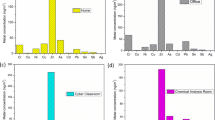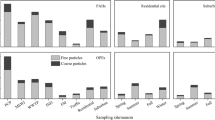Abstract
The airborne particle-bound elements (Ca, Fe, Al, Mg, K, Na, Zn, Mn, P, Pb, Cu, Sr, Ti, Ba, Cr, Ni, As, Sb, Cd, Co, and V) trapped in room air conditioners’ filters (filter dusts) during recirculating indoor air from different types of rooms were analyzed, and the objectives of this study were to assess the potential sources of those elements and their potential health risks via inhalation/ingestion exposure. Main crustal elements such as Ca, Fe, Al, Mg, and K with an average value of 60.6, 17.9, 11.3, 7.58, and 6.90 mg g−1, respectively, are the preponderant elements, and the mean values of main toxic elements were 2230, 344, 508, 85.7, 71.5, 36.0, 8.02, and 16.9 mg kg−1 for Zn, Cu, Pb, Cr, Ni, As, Cd, and Sb, respectively. The enrichment factors indicated the significant enrichment of Cd, Pb, Cr, Cu, Sb, and Zn in the filter dusts. Four potential sources with the contributions of 33.5, 29.1, 22.6, and 14.8%, respectively, were identified by absolute principal component scores-multiple linear regression analysis (APCS-MLR). Enrichment factor and APCS-MLR model reveal the outdoor input of toxic elements. In vitro inhalation and ingestion bioaccessibility of toxic elements showed elemental and in vitro procedure dependence. There are potential carcinogenic risks via ingestion exposure and no non-carcinogenic risks to both children and adults based on bioaccessible contents of toxic elements. This study reveals the potential health risks posed by the particle-bound elements.

Similar content being viewed by others
References
Batterman S, Du L, Mentz G, Mukherjee B, Parker E, Godwin C, Chin JY, O'Toole A, Robins T, Rowe Z, Lewis T (2012) Particulate matter concentrations in residences: an intervention study evaluating stand-alone filters and air conditioners. Indoor Air 22:235–252
Besis A, Katsoyiannis A, Botsaropoulou E, Samara C (2014) Concentrations of polybrominated diphenyl ethers (PBDEs) in central air-conditioner filter dust and relevance of non-dietary exposure in occupational indoor environments in Greece. Environ Pollut 188:64–70
Boisa N, Elom N, Dean JR, Deary ME, Bird G, Entwistle JA (2014) Development and application of an inhalation bioaccessibility method (IBM) for lead in the PM10 size fraction of soil. Environ Int 70:132–142
Chen C, Zhao B (2011) Review of relationship between indoor and outdoor particles: I/O ratio, infiltration factor and penetration factor. Atmos Environ 45:275–288
Chen JM, Tan MG, Li YL, Zheng J, Zhang YM, Shan Z, Zhang GL, Li Y (2008) Characteristics of trace elements and lead isotope ratios in PM2.5 from four sites in Shanghai. J Hazard Mater 156:36–43
Cheng Z, Jiang JK, Fajardo O, Wang SX, Hao JM (2013) Characteristics and health impacts of particulate matter pollution in China (2001-2011). Atmos Environ 65:186–194
CNEMC (China National Environmental Monitoring Center) (1990) China background values of soil elements. Environmental Science Press of China, Beijing (In Chinese)
Coufalik P, Mikuska P, Matousek T, Vecera Z (2016) Determination of the bioaccessible fraction of metals in urban aerosol using simulated lung fluids. Atmos Environ 140:469–475
Ding ZH, Hu X (2014) Ecological and human health risks from metal(loid)s in peri-urban soil in Nanjing, China. Environ Geochem Health 36:399–408
Duan JC, Tan JH (2013) Atmospheric heavy metals and arsenic in China: situation, sources and control policies. Atmos Environ 74:93–101
Fang GC, Huang YL, Huang JH (2010) Study of atmospheric metallic elements pollution in Asia during 2000-2007. J Hazard Mater 180:115–121
Garcia-Santiago X, Gallego-Fernandez N, Muniategui-Lorenzo S, Pineiro-Iglesias M, Lopez-Mahia P, Franco-Uria A (2017) Integrative health risk assessment of air pollution in the northwest of Spain. Environ Sci Pollut Res 24:3412–3422
Gietl JK, Lawrence R, Thorpe AJ, Harrison RM (2010) Identification of brake wear particles and derivation of a quantitative tracer for brake dust at a major road. Atmos Environ 44:141–146
Harrison RM, Smith DJT, Luhana L (1996) Source apportionment of atmospheric polycyclic aromatic hydrocarbons collected from an urban location in Birmingham, UK. Environ Sci Technol 30:825–832
Hu X, Zhang Y, Luo J, Wang TJ, Lian HZ (2011) Total concentrations and fractionation of heavy metals in road-deposited sediments collected from different land use zones in a large city (Nanjing), China. Chem Speciat Bioavailab 23:46–52
Hu X, Zhang Y, Ding ZH, Wang TJ, Lian HZ, Sun YY, Wu JC (2012) Bioaccessibility and health risk of arsenic and heavy metals (cd, co, Cr, cu, Ni, Pb, Zn and Mn) in TSP and PM2.5 in Nanjing, China. Atmos Environ 57:146–152
Hu X, Ding Z, Zhang Y, Sun Y, Wu J, Chen Y, Lian H (2013) Size distribution and source apportionment of airborne metallic elements in Nanjing, China. Aerosol Air Qual Res 13:1796–1806
Huang M, Wang W, Chan CY, Cheung KC, Man YB, Wang X, Wong MH (2014) Contamination and risk assessment (based on bioaccessibility via ingestion and inhalation) of metal(loid)s in outdoor and indoor particles from urban centers of Guangzhou, China. Sci Total Environ 479:117–124
Huang X, Betha R, Tan LY, Balasubramanian R (2016) Risk assessment of bioaccessible trace elements in smoke haze aerosols versus urban aerosols using simulated lung fluids. Atmos Environ 125:505–511
Huang H, Jiang Y, Xu XY, Cao XD (2018) In vitro bioaccessibility and health risk assessment of heavy metals in atmospheric particulate matters from three different functional areas of shanghai, China. Sci Total Environ 610:546–554
Ibanez Y, Le Bot B, Glorennec P (2010) House-dust metal content and bioaccessibility: a review. Eur J Mineral 22:629–637
ISO (International Organization for Standardization) (1995) Soil quality, extraction of trace elements soluble in aqua regia. ISO 11466
Juhasz AL, Smith E, Nelson C, Thomas DJ, Bradham K (2014) Variability associated with As in vivo-in vitro correlations when using different bioaccessibility methodologies. Environ Sci Technol 48:11646–11653
Kang Y, Liu GJ, Chou CL, Wong MH, Zheng LG, Ding R (2011) Arsenic in Chinese coals: distribution, modes of occurrence and environmental effects. Sci Total Environ 412:1–13
Kastury F, Smith E, Juhasz AL (2017) A critical review of approaches and limitations of inhalation bioavailability and bioaccessibility of metal(loid)s from ambient particulate matter or dust. Sci Total Environ 574:1054–1074
Kim KH, Kabir E, Kabir S (2015) A review on the human health impact of airborne particulate matter. Environ Int 74:136–143
Li HB, Cui XY, Li K, Li J, Juhasz AL, Ma LQ (2014) Assessment of in vitro lead bioaccessibility in house dust and its relationship to in vivo lead relative bioavailability. Environ Sci Technol 48:8548–8555
Liu YZ, Ma JW, Yan HX, Ren YQ, Wang BB, Lin CY, Liu XT (2016) Bioaccessibility and health risk assessment of arsenic in soil and indoor dust in rural and urban areas of Hubei province, China. Ecotoxicol Environ Saf 126:14–22
Mukhtar A, Limbeck A (2013) Recent developments in assessment of bio-accessible trace metal fractions in airborne particulate matter: a review. Anal Chim Acta 774:11–25
Ng JC, Juhasz A, Smith E, Naidu R (2015) Assessing the bioavailability and bioaccessibility of metals and metalloids. Environ Sci Pollut Res 22:8802–8825
NMBS (Nanjing Municipal Bureau of Statistics) (2014) The Statistical Yearbook (2013) of Nanjing. http://221.226.86.104/file/nj2004/2014/index.htm
Olowoyo JO, Mugivhisa LL, Sithole SC (2015) Exposure to trace metals from dust samples collected from air conditioning systems and carpets from offices in a university. Trace Elem Electroly 32:225–232
Praveena SM, Mutalib NSA, Aris AZ (2015) Determination of heavy metals in indoor dust from primary school (Sri Serdang, Malaysia): estimation of the health risks. Environ Forensic 16:257–263
Siddique N, Majid A, Tufail M (2011) Elemental analysis of dust trapped in air conditioner filters for the assessment of Lahore city’s air quality. J Radioanal Nucl Chem 290:691–699
Smith E, Scheckel K, Miller BW, Weber J, Juhasz AL (2014) Influence of in vitro assay pH and extractant composition on As bioaccessibility in contaminated soils. Sci Total Environ 473:171–177
Snape I, Scouller R, Stark S, Stark J, Riddle M, Gore D (2004) Characterisation of the dilute HCl extraction method for the identification of metal contamination in Antarctic marine sediments. Chemosphere 57:491–504
Sun YY, Hu X, Wu JC, Lian HZ, Chen YJ (2014) Fractionation and health risks of atmospheric particle-bound As and heavy metals in summer and winter. Sci Total Environ 493:487–494
Sutherland RA, Tack FMG, Tolosa CA, Verloo MG (2001) Metal extraction from road sediment using different strength reagents: impact on anthropogenic contaminant signals. Environ Monit Assess 71:221–242
Thurston GD, Ito K, Lall R (2011) A source apportionment of U.S. fine particulate matter air pollution. Atmos Environ 45:3924–3936
Tian HZ, Lu L, Cheng K, Hao JM, Zhao D, Wang Y, Jia WX, Qiu PP (2012) Anthropogenic atmospheric nickel emissions and its distribution characteristics in China. Sci Total Environ 417:148–157
Turner A (2011) Oral bioaccessibility of trace metals in household dust: a review. Environ Geochem Health 33:331–341
Turner A, Ip KH (2007) Bioaccessibility of metals in dust from the indoor environment: application of a physiologically based extraction test. Environ Sci Technol 41:7851–7856
Twining J, McGlinn P, Loi E, Smith K, Giere R (2005) Risk ranking of bioaccessible metals from fly ash dissolved in simulated lung and gut fluids. Environ Sci Technol 39:7749–7756
Wang BQ, Liu JF, Ren ZH, Chen RH (2016a) Concentrations, properties, and health risk of PM2.5 in the Tianjin City subway system. Environ Sci Pollut Res 23:22647–22657
Wang JH, Li SW, Cui XY, Li HM, Qian X, Wang C, Sun YX (2016b) Bioaccessibility, sources and health risk assessment of trace metals in urban park dust in Nanjing, Southeast China. Ecotoxicol Environ Saf 128:161–170
Wiseman CLS (2015) Analytical methods for assessing metal bioaccessibility in airborne particulate matter: a scoping review. Anal Chim Acta 877:9–18
Zhang Y, Chen H, Wang J, Meng Q (2016) Thermal comfort of people in the hot and humid area of China-impacts of season, climate, and thermal history. Indoor Air 26:820–830
Zia MH, Codling EE, Scheckel KG, Chaney RL (2011) In vitro and in vivo approaches for the measurement of oral bioavailability of lead (Pb) in contaminated soils: a review. Environ Pollut 159:2320–2327
Acknowledgements
The work was supported by the National Natural Science Fund of China (No. 91543129, 91544230).
Author information
Authors and Affiliations
Corresponding author
Additional information
Responsible editor: Philippe Garrigues
Electronic supplementary material
ESM 1
(DOCX 47 kb)
Rights and permissions
About this article
Cite this article
Hu, X., Xu, X., Ding, Z. et al. In vitro inhalation/ingestion bioaccessibility, health risks, and source appointment of airborne particle-bound elements trapped in room air conditioner filters. Environ Sci Pollut Res 25, 26059–26068 (2018). https://doi.org/10.1007/s11356-018-2403-6
Received:
Accepted:
Published:
Issue Date:
DOI: https://doi.org/10.1007/s11356-018-2403-6




